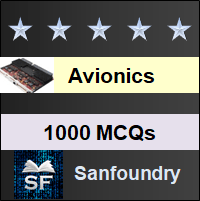
Avionics Multiple Choice Questions Highlights
- 1000+ Multiple Choice Questions & Answers (MCQs) in Avionics with a detailed explanation of every question.- These MCQs cover theoretical concepts, true-false(T/F) statements, fill-in-the-blanks and match the following style statements.
- These MCQs also cover numericals as well as diagram oriented MCQs.
- These MCQs are organized chapterwise and each Chapter is futher organized topicwise.
- Every MCQ set focuses on a specific topic of a given Chapter in Avionics Subject.
Who should Practice Avionics MCQs?
– Students who are preparing for college tests and exams such as mid-term tests and semester tests on Avionics.- Students who are preparing for Online/Offline Tests/Contests in Avionics.
– Students who wish to sharpen their knowledge of Avionics Subject.
- Anyone preparing for Aptitude test in Avionics.
- Anyone preparing for interviews (campus/off-campus interviews, walk-in interview and company interviews).
- Anyone preparing for entrance examinations and other competitive examinations.
- All - Experienced, Freshers and College / School Students.
Avionics Chapters
Here's the list of chapters on the "Avionics" subject covering 100+ topics. You can practice the MCQs chapter by chapter starting from the 1st chapter or you can jump to any chapter of your choice.- Displays and Man-Machine Interaction
- Fly by Wire Flight Control
- Autopilots and Flight Management Systems
- Avionics System Integration
- Introduction to Electronic Communication
- Fundamentals of Electronics
- Amplitude & Frequency Modulation
- Digital Communication Techniques
- Radio Transmitters, Communication Receivers, Multiplexing and Demultiplexing
- Transmission Lines
- Antennas and Wave Propagation
- Satellite Communication
- Introduction & Navigation Equations
- Terrestrial Radio Navigation System
- Satellite Radio Navigation & Inertial Navigation
- Air Data Systems, Altitude and Heading Reference
- Celestial Navigation, Doppler and Altimeter Radars
- Landing Systems & Air-Traffic Management
- Surveillance Systems, Mapping and Multimode Radars
1. Displays and Man-Machine Interaction
The section contains multiple choice questions and answers on head up and helmet mounted displays, head down display technology, control and data entry.
|
|
|
2. Fly by Wire Flight Control
The section contains questions and answers on fly by wire technology, fbw control laws, fbw redundancy and dailure survival, digital implementation and fly by light flight control.
|
|
|
3. Autopilots and Flight Management Systems
The section contains MCQs on autopilots, height and heading control, flight management systems, ils/mls coupled landing system and automatic landing.
4. Avionics System Integration
The section contains multiple choice questions and answers on data bus systems, modular avionics architectures and uav avionics.
|
|
|
5. Introduction to Electronic Communication
The section contains questions and answers on electronic communication types, electromagnetic spectrum, modulation and multiplexing.
|
|
|
6. Fundamentals of Electronics
The section contains MCQs on gain, attenuation, decibels, tuned circuits, filters and fourier theory.
|
|
|
7. Amplitude & Frequency Modulation
The section contains multiple choice questions and answers on amplitude modulation, modulation index, sidebands, frequency domain, single sideband and phase modulation, fm noise suppression effects and modulation index.
|
|
|
8. Digital Communication Techniques
The section contains questions and answers on data digital transmission, parallel and serial transmission, data conversion, pulse modulation and digital signal processing.
|
|
|
9. Radio Transmitters, Communication Receivers, Multiplexing and Demultiplexing
The section contains MCQs on radio transmitters, communication receivers, pulse code modulation, frequency and time division multiplexing.
|
|
|
10. Transmission Lines
The section contains multiple choice questions and answers on transmission line basics, standing waves and transmission lines as circuit elements.
|
|
|
11. Antennas and Wave Propagation
The section contains questions and answers on antenna fundamentals and types.
|
|
|
12. Satellite Communication
The section contains MCQs on satellite orbits, satellite communication syatems and subsystems, ground stations and satellite applications.
|
|
|
13. Introduction & Navigation Equations
The section contains multiple choice questions and answers on guidance and navigation, flight phases and navigation equations.
|
|
|
14. Terrestrial Radio Navigation System
The section contains questions and answers on radio propagation, noise characteristics, point source and hyperbolic radio systems.
|
|
|
15. Satellite Radio Navigation & Inertial Navigation
The section contains MCQs on orbital mechanics, clock characteristics, satellite signals atmospheric effects, navstar gps, global orbiting navigational satellite system, accelerometer, gyroscopes, strap down and gimballed inertial navigation systems.
16. Air Data Systems, Altitude and Heading Reference
The section contains multiple choice questions and answers on pressure measurements, side slip measurements, air data equations and computers, helicopter, optical and hyper sonic air data, vertical and heading references.
|
|
|
17. Celestial Navigation, Doppler and Altimeter Radars
The section contains questions and answers on doppler radar, radar altimeter, stellar inertial navigation theory and stellar sensor design.
|
|
|
18. Landing Systems & Air-Traffic Management
The section contains MCQs on landing mechanics, automatic and instrument landing systems, microwave landding system, air traffic control, satellite and carrier landing systems.
19. Surveillance Systems, Mapping and Multimode Radars
The section contains multiple choice questions and answers on electronic scanned array radar, primary and secondary radar, modes s system, traffic alert, collision avoidance system and weather radar.
|
|
|
Wish you the best in your endeavor to learn and master Avionics!
